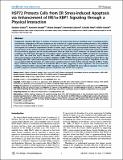| dc.contributor.author | Gupta, Sanjeev | en |
| dc.contributor.author | Deepti, Ayswaria | en |
| dc.contributor.author | Deegan, Shane | en |
| dc.contributor.author | Samali, Afshin | en |
| dc.date.accessioned | 2010-07-21T15:28:40Z | en |
| dc.date.available | 2010-07-21T15:28:40Z | en |
| dc.date.issued | 2010 | en |
| dc.identifier.citation | Gupta S, Deepti A, Deegan S, Lisbona F, Hetz C, et al. (2010) HSP72 Protects Cells from ER Stress-induced Apoptosis via Enhancement of IRE1a-XBP1 | en |
| dc.identifier.uri | http://hdl.handle.net/10379/1215 | en |
| dc.description.abstract | Endoplasmic reticulum (ER) stress is a feature of secretory cells and of many diseases including cancer, neurodegeneration, and diabetes. Adaptation to ER stress depends on the activation of a signal transduction pathway known as the unfolded protein response (UPR). Enhanced expression of Hsp72 has been shown to reduce tissue injury in response to stress stimuli and improve cell survival in experimental models of stroke, sepsis, renal failure, and myocardial ischemia. Hsp72 inhibits several features of the intrinsic apoptotic pathway. However, the molecular mechanisms by which Hsp72 expression inhibits ER stress-induced apoptosis are not clearly understood. Here we show that Hsp72 enhances cell survival under ER stress conditions. The UPR signals through the sensor IRE1¿, which controls the splicing of the mRNA encoding the transcription factor XBP1. We show that Hsp72 enhances XBP1 mRNA splicing and expression of its target genes, associated with attenuated apoptosis under ER stress conditions. Inhibition of XBP1 mRNA splicing either by dominant negative IRE1¿ or by knocking down XBP1 specifically abrogated the inhibition of ER stress-induced apoptosis by Hsp72. Regulation of the UPR was associated with the formation of a stable protein complex between Hsp72 and the cytosolic domain of IRE1¿. Finally, Hsp72 enhanced the RNase activity of recombinant IRE1¿ in vitro, suggesting a direct regulation. Our data show that binding of Hsp72 to IRE1¿ enhances IRE1¿/XBP1 signaling at the ER and inhibits ER stress-induced apoptosis. These results provide a physical connection between cytosolic chaperones and the ER stress response. | en |
| dc.description.sponsorship | SFI | en |
| dc.format | application/pdf | en |
| dc.language.iso | en | en |
| dc.rights | Attribution-NonCommercial-NoDerivs 3.0 Ireland | |
| dc.rights.uri | https://creativecommons.org/licenses/by-nc-nd/3.0/ie/ | |
| dc.subject | Biochemistry | en |
| dc.title | HSP72 Protects Cells from ER Stress-induced Apoptosis via Enhancement of IRE1¿-XBP1 Signaling through a Physical Interaction | en |
| dc.type | Article | en |
| dc.local.publishedsource | http://www.ncbi.nlm.nih.gov/pmc/articles/PMC2897763 | en |
| dc.description.peer-reviewed | peer-reviewed | en |
| nui.item.downloads | 578 | |


